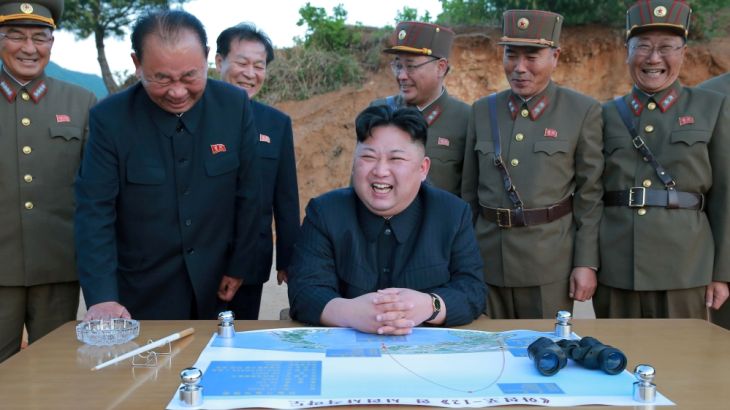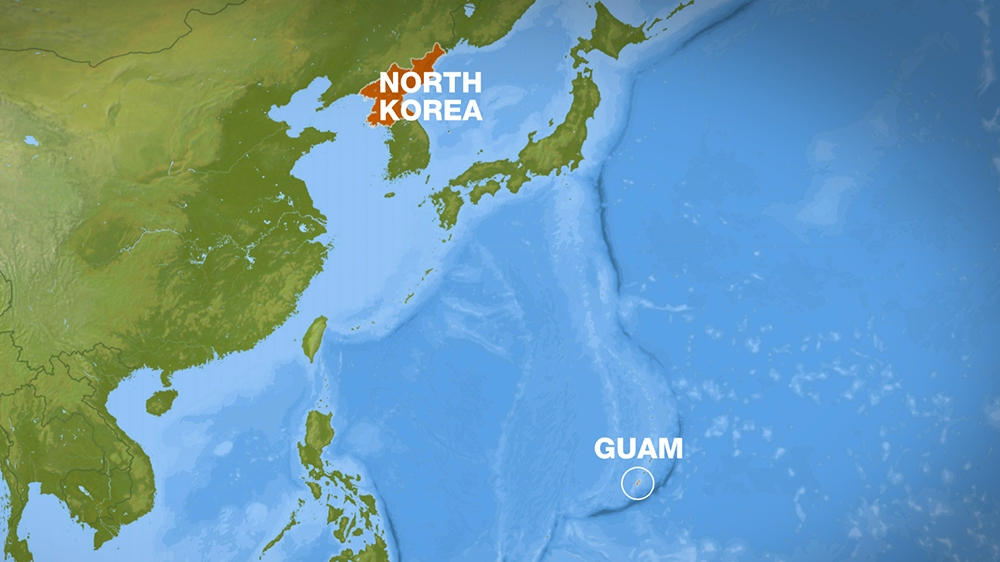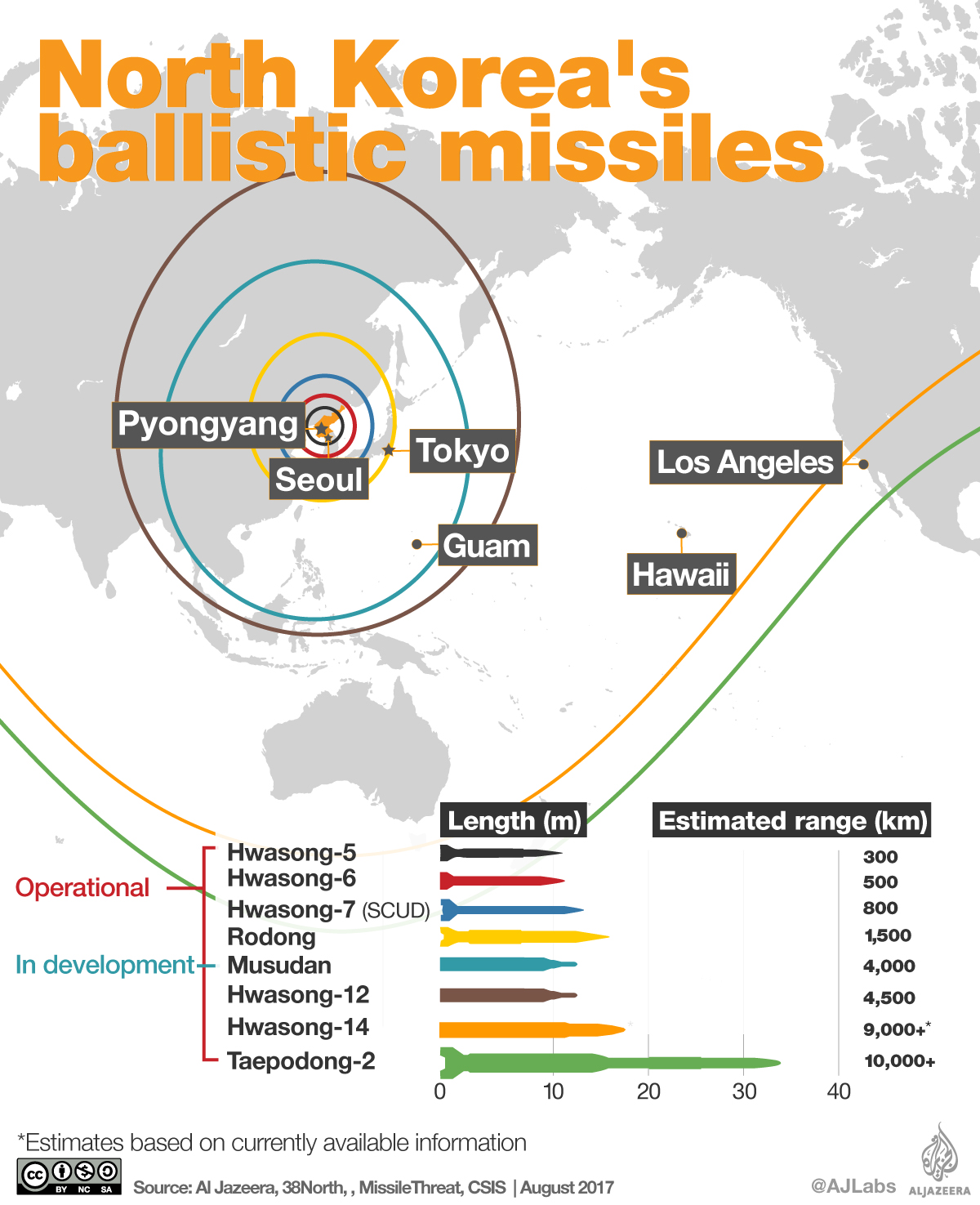North Korea will develop Guam attack plan by mid-August
A plan will be presented to leader Kim Jong-un who will make a decision on whether to proceed, said North’s state media.

North Korea will develop a plan by mid-August to launch four intermediate range missiles at the US territory of Guam before presenting it to leader Kim Jong-un who will decide on whether to proceed, North Korean state media said on Thursday.
The unusually detailed report on the attack plan marked a further escalation in tensions between Pyongyang and Washington after US President Donald Trump warned North Korea earlier this week it would face “fire and fury” if it threatened the United States.
North Korea’s official news agency KCNA described Trump’s threat as a “load of nonsense”.
“Sound dialogue is not possible with such a guy bereft of reason and only absolute force can work on him,” it said of Trump, adding that it will keep closely watching the speech and behaviour of the US.
READ MORE: Three things to know about North Korea’s missile tests
The North Korean army is developing a plan “in order to interdict the enemy forces on major military bases on Guam and to signal a crucial warning to the United States,” the KCNA report said.
Guam is home to about 163,000 people and a US military base that includes a submarine squadron, an airbase and a coastguard group.
“The Hwasong-12 rockets to be launched by the KPA (Korean People’s Army) will cross the sky above Shimane, Hiroshima and Koichi Prefectures of Japan,” the report said, citing General Kim Rak Gyom, commander of the Strategic Force of the KPA.
|
|
“They will fly 3,356.7 km for 1,065 seconds and hit the waters 30 to 40 km away from Guam.”
Earlier on Wednesday, Guam Governor Eddie Calvo dismissed the threat and said the island was prepared for “any eventuality” with strategically placed defences. He said he had been in touch with the White House and there was no change in the threat level.
US military officials played down the potential for military conflict. Three US officials speaking to Reuters news agency on condition of anonymity said the US had not moved additional assets into the region after North Korea’s threats against Guam.
“Just because the rhetoric goes up, doesn’t mean our posture changes,” one official said. “The only time our posture goes up is based on facts, not because of what Kim and Trump say to each other,” the official added.
Al Jazeera’s Craig Leeson, reporting from Guam, said that North Korea has been described in the past as a “small dog with a big bark” and that is was “business as usual” in Guam.
“Now we’re seeing Guam being used by North Korea as a sort of a stick against Donald Trump but at this stage one would suspect that it is a typical North Korean tactic merely saying to Donald Trump ‘back off, leave us alone, stop with the sanctions, and let us get on with our own lives’,” he said.
“So at this stage, it is being seen I think by most people – certainly people here in Guam – as just purely rhetoric.” said Leeson.

A week of rising tension
Tensions surged this week after Trump’s warning to the isolated state to give up its nuclear weapons and missile programmes.
Washington has warned it is ready to use force if needed to stop North Korea’s ballistic missile and nuclear programmes but that it prefers global diplomatic action, including sanctions. The UN Security Council unanimously imposed new sanctions on North Korea on Saturday.
North Korea carried out two nuclear bomb tests last year and two intercontinental ballistic missile tests in July. Trump has said he will not allow Pyongyang to develop a nuclear weapon capable of hitting the US.
OPINION: Is North Korea really a ‘hollowed out’ state?
US Secretary of Defense Jim Mattis also issued a stark warning to North Korea on Wednesday, telling Pyongyang it should stop any actions that would lead to the “end of its regime and the destruction of its people”.
Al Jazeera’s Patty Culhane, reporting from Washington, DC, said the messages coming out of the Trump administration on North Korea over the past few weeks have been very inconsistent.
“That it was time to talk. That it wasn’t time to talk. That regime change was on the table. That it wasn’t. Nevertheless, here at the State Department, they insist that when it comes to North Korea, they are speaking with one voice,” she said.
